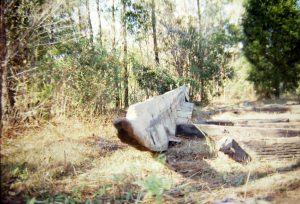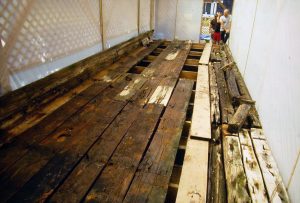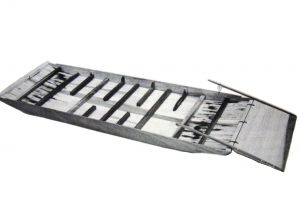Trent River Flat Boat (Craven County)
On December 2, 1988, staff from the Underwater Archaeology Branch (UAB) of the Office of State Archaeology responded to a call from a construction company building a private pier on the Trent River near New Bern, North Carolina. A few weeks earlier, while driving pilings at the water’s edge, Larry Arnold hit a mass of wood pieces, some of which he dragged ashore. Recognizing the hand-hewn workmanship, age, and significance of the timbers, Arnold called authorities to report the find, which led to UAB’s initial inspection and subsequent investigation of the sunken vessel by Richard Kimmel (US Army Corps of Engineers, Wilmington District) and Mike Alford (maritime curator of the North Carolina Maritime Museum).
Removal from the River

Under the watchful eyes of Kimmel and Alford, a team of archaeologists documented and removed from the river the surviving timbers of a wooden flat boat or barge measuring 32 by 11 feet. They worked in the water without dive gear since the submerged site lay only three to four feet below the river’s surface. Archaeologists in the water relayed information about each timber to another team member on the dock where it could be recorded. Then, timber by timber, the flat boat was disassembled, raised to the water’s surface, and carefully moved to dry land. Once fully removed from the water, archaeologists reassembled the pieces of the flat boat, then tagged, mapped, and photographed each timber before loading it on to a truck for transport to the North Carolina Maritime Museum in Beaufort.

The vessel was ninety percent complete, missing only one side piece and two side supports (known as knees in nautical terms). The rescued pieces included six of the eight knees, seven bottom beams from the boat’s floor, 11 bottom planks, and two apron boards fitted at each end to act as ramps for loading and unloading cargo.
Original Construction Techniques
The one (of two) side pieces that survived gave archaeologists important information about how the flat boat had been constructed more than two hundred years ago. The sides began as a large cypress tree that was carved out in the middle using axes and adzes, much like a dugout canoe. The hollowed tree was then sawn down the middle to create two opposite sides, which became the sides of the vessel. These hand-hewn side planks measured more than 31 feet in length by over 17 inches in depth with a thickness of 2-½ inches. Appearing L-shaped in cross section, the bottom of the plank featured a shelf-like extension characteristic of a boat building technique called chine log construction.

Once the tree had been separated into two halves and hand-hewn to proper shape, the two pieces were spread apart 11 feet and and beams (called floors by shipwrights) sawn from oak trees were placed crosswise with their ends resting on the shelf on either side section. Knees, shorter beams carved from cypress tree roots, curved at a right-angle on one end were attached to the sides to provide overall strength at the side and bottom junctures of the vessel. To complete the flat boat, long wide planks cut from pine trees were attached underneath the floors and knees using a combination of iron spikes and wooden pegs (also known as treenails).
Conservation Efforts

Once removed from the river, the surviving remains of the flat boat were transported to an outdoor facility at the North Carolina Maritime Museum in Beaufort where conservators began an innovative endeavor to preserve it. The conservation effort, funded by the Kellenberger Foundation, was largely unsuccessful, but it highlighted the challenges and costs involved in saving a large, water-logged, wooden relic in its entirety.
The Trent River had sheltered the sunken vessel in a favorable environment (low-light, acidic waters) for more than 200 years, aiding in its preservation. Once the wooden timbers were removed from the water they needed to be dried—a process that can cause cracking and shrinking of the beams, especially in woods such as pine and oak which formed nearly the entire boat (except for the cypress side pieces). Because funds were limited and proven conservation methods using polyethylene glycol were very expensive, conservators decided to try an experimental treatment regimen using ethylene glycol, also known as anti-freeze, as the primary preservative for the salvaged timbers. An existing structure at the Museum was enclosed in plastic and a spray pump system was installed that continuously doused the timbers with ethylene glycol until all of the water in the wood had been replaced with the preservative. Then the timbers were slowly dried. Unfortunately, all but one of the timbers were lost to shrinking and cracking; only the cypress side piece survived. Although the experimental conservation effort did not successfully preserve the Trent River Flat Boat, the detailed archaeological excavation and documentation of the vessel recovered enough details for a precise model to be built. This replica is preserved for future research and public display.
The Flat’s Significance

Log chine construction techniques identified on the side piece of the Trent River Flat Boat are characteristic of Old World practices that extended back to Roman times. Shipbuilders in France were know to have used these techniques beginning in the eleventh through the eighteenth centuries also used them. French Huguenots settled the lower Trent River in the beginning of the eighteenth century, and apparently brought their boat building techniques with them as evident from the sunken vessel found in the shallows of the Trent River. Eighteenth century maps record Murphy’s Ferry near where the remains were found, so the flat boat may have been used to ferry people and products back and forth across the river. Alternatively, its location near the confluence of a navigable creek and the Trent River suggests the vessel may have moved agricultural goods from fields to the market in New Bern. The craft could have carried up to 4-½ tons of cargo, livestock, and vehicles during its time in use in the first half of the nineteenth century, although its service could have extended decades before or after this date.
Contributor
Mark U. Wilde-Ramsing (Retired, Underwater Archaeology Branch, Office of State Archaeology, North Carolina Department of Natural and Cultural Resources)
*Images courtesy of the Underwater Archaeology Branch, Office of State Archaeology, North Carolina Department of Natural and Cultural Resources
Sources
Alford, Michael B.
1990 • Trent River Flat Boat: Report to the Kellenberger Foundation. Manuscript on file with the North Carolina Underwater Archaeology Branch, Kure Beach.
Alford, Michael B.
1991 • The Ferry from the Trent: Researching Colonial River Ferries. Tributaries October 1991.
Alford, Michael B.
1992 • Origins of the North Carolina Split-Dugout Canoes. International Journal of Nautical Archaeology 21(3):191-203.
Kimmel, Richard
1988 • Field Inspection of Archaeological Site (Permit applicant Gerald Delany, October 11, 1988, G.P.’s SAWCO78-N-019-0056 and 025-0080; CAMA permit C-4634, December 6, 1988). Memorandum on file with the North Carolina Underwater Archaeology Branch, Kure Beach.
